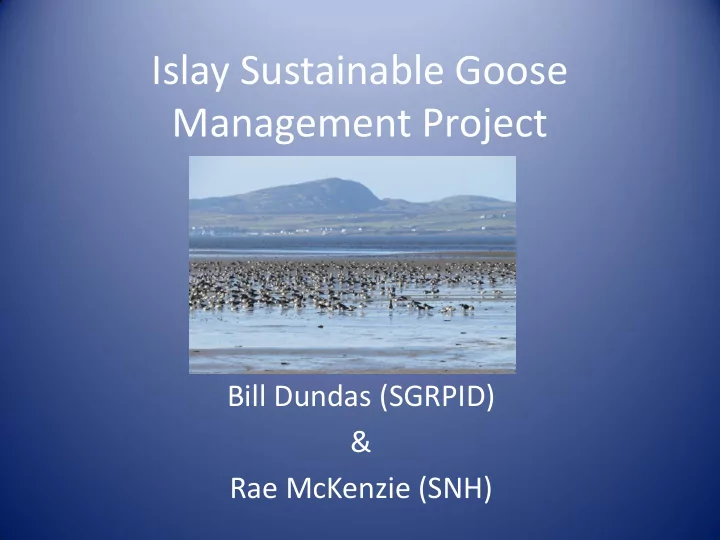

Islay Sustainable Goose Management Project Bill Dundas (SGRPID) & Rae McKenzie (SNH)
Background Historical goose numbers Barnacle goose numbers – Islay - 1952-2013
Background Historical goose numbers Greenland white-fronted goose numbers – Islay - 1970 - 2013
Islay goose management • 1984 - RSPB reserve at Gruinart set up as a refuge • 1988 - NCC set up management agreements with individual SPA farmers. Scaring scheme in other parts of the island. • 1992 - Whole island goose scheme set up (feeding scheme) • 2000 - Current scheme model set up (management scheme) • Reviews of scheme in 2005, 2008, 2010 and 2012
National goose policy objectives The established objectives for goose management schemes in Scotland are: • Meet the UK's nature conservation obligations for geese, within the context of wider biodiversity objectives • Minimise economic losses experienced by farmers and crofters as a result of the presence of geese • Maximise the value for money of public expenditure
Current Islay scheme • Developed from the model set up in 2000 • All agricultural holdings on Islay are eligible to enter • Farmers must allow geese to feed on at least 60% of their grass area • Farmers are paid compensation based on their losses due to goose damage. • Current payments do not cover 100% of the cost of goose damage.
Current Islay scheme • Scaring can take place on up to 40% of the grass area, including 1 st and 2 nd year reseeds • Scaring can be non-lethal using human scaring, dogs, quad bikes and scaring devices • Lethal scaring of barnacle geese can take place under licence on certain fields. • This year’s bag limit is 1800 barnacle geese • No shooting should take place if there are white-fronts within the flock • Farmers can apply to scare geese from their whole farm for 1 month at either the beginning or end of the season
Scaring methods Peace pyramid Squawker Self launching kite Gas gun Scary man
Scaring methods Canes & streamers
Development of Islay project Why is the Islay Sustainable Goose Management Project needed? • White-front numbers have fallen • Barnacle goose numbers have not stabilised • Farming costs have increased • Compensation payments are significantly less than costs of supporting geese • A wish by Islay farmers to reduce impacts from geese to a level where they could maximise their income from farming • Goose damage remains serious
Goose damage
Article 9 EC Birds Directive Member States may derogate from the provisions of Articles 5, 6, 7 and 8, where there is no other satisfactory solution, for the following reasons: (a) • in the interests of public health and safety, • in the interests of air safety, • to prevent serious damage to crops , livestock, forests, fisheries and water, • for the protection of flora and fauna; (b) • for the purposes of research and teaching, of re-population, of reintroduction and for the breeding necessary for these purposes; (c) • to permit, under strictly supervised conditions and on a selective basis, the capture, keeping or other judicious use of certain birds in small numbers.
Satisfactory solutions • Scaring – non-lethal? – Geese have become habituated to non-lethal methods • Scaring – lethal? – Temporary effects but the scaring programme has not reduced the damage by the levels needed • Compensation? – Money in itself does not prevent damage
Islay long term plan The established objectives for goose management schemes in Scotland are: • Minimise economic losses experienced by farmers and crofters as a result of the presence of geese • Meet the UK's nature conservation obligations for geese, within the context of wider biodiversity objectives • Maximise the value for money of public expenditure The plan will seek to address these objectives on Islay and will also consider how meeting these objectives will impact on other interests on Islay such as tourism, and sporting interests.
Islay long term plan • 10 year plan • Measure damage – set targets using those measurements. • Management to maintain/increase white-front numbers • Management to reduce damage by barnacle geese by reducing population • Management to minimise damage by other goose species • Adaptive management approach
Adaptive management • Is process by which ecological uncertainty is reduced via diagnostic management experiments. • It is not a management action • It works by setting out actions which we predict will have certain outcomes • Actions will be monitored and adjusted if necessary. • The Islay plan will be reviewed every 2 years to ensure that actions are working towards predicted outcomes.
Greenland white-fronted geese • Aim to increase population • Minimise impacts of disturbance • Habitat management to improve condition of traditional feeding areas • Diversionary feeding
Barnacle geese • Reduce damage caused by barnacle geese • On- going scaring activities & trials of new methods • Use sward height and rotational frequency to measure damage • Set targets based on damage reduction • Aim to reduce damage to agreed levels by certain points of the plan by reducing the population
Trials of different scaring methods Sonic or humming string Crop protection netting
Other goose species • Aim to ensure that impacts of greylag or Canada geese do not increase over the plan period • Prevent further increases in greylag geese • Ensure greylag geese do not impact on management for other species • Prevent Canada geese from establishing breeding sites
Next steps • Develop final Islay plan • Liaise with other countries across range • Collect baseline data • Develop scheme from plan • Identify funding
Recommend
More recommend